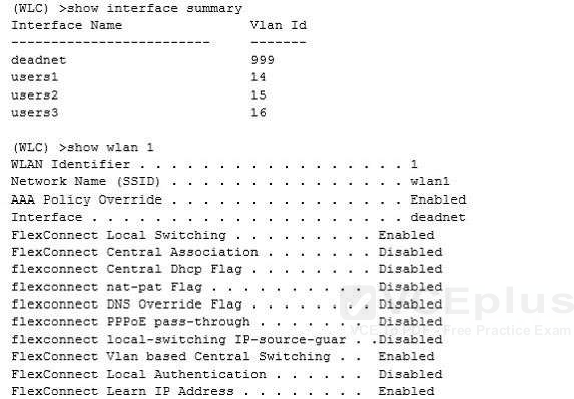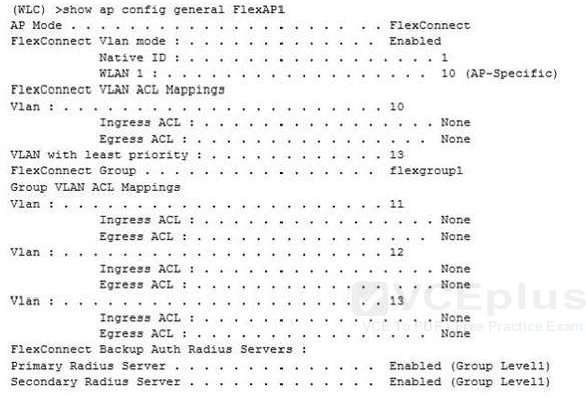Refer to Exhibit.


A wireless client is connecting to FlexAPI which is currently working standalone mode. The AAA authentication process is returning the following AVPs:
Tunnel-Private-Group-ld(81): 15
Tunnel-Medium-Type(65):IEEE-802(6) Tunnel-Type(64): VLAN(13)
Which three behaviors will the client experience? (Choose three.)
A. While the AP is in standalone mode, the client will be placed in VLAN 15.
B. While the AP is in standalone mode, the client will be placed in VLAN 10.
C. When the AP transitions to connected mode, the client will be de-authenticated.
D. While the AP is in standalone mode, the client will be placed in VLAN 13.
E. When the AP is in connected mode, the client will be placed in VLAN 13.
F. When the AP transitions to connected mode the client will remain associated.
G. When the AP is in connected mode, the client will be placed in VLAN 15. H. When the AP is in connected mode, the client will be placed in VLAN 10.


Can someone explain, below question:
G. When the AP is in connected mode, the client will be placed in VLAN 15.
■If the VLAN is returned as one of the AAA attributes and that VLAN is not present in the Flex AP database, traffic will switch centrally. If that VLAN is also not present on the WLC, the client will be assigned a VLAN/Interface mapped to a WLAN on the WLC.
Where are we getting VLAN15, as I do not see it mapped under “Config General FlexAP1”
The Tunnel-Private-Group-ld(81): 15 setting refers to a VLAN assigned by the AAA server. Check this reference:
https://www.cisco.com/c/en/us/td/docs/ios-xml/ios/sec_usr_8021x/configuration/15-e/sec-usr-8021x-15-e-book/sec-vlan-dot1x-auth-request.html
B C G
I believe correct answer is
B; C; G
Please see below:
Traffic flow on WLANs configured for Local Switching when Flex APs are in Connected Mode:
■If the VLAN is returned as one of the AAA attributes and that VLAN is not present in the Flex AP database, traffic will switch centrally and the client will be assigned this VLAN/Interface returned from the AAA server provided that the VLAN exists on the WLC.
■If the VLAN is returned as one of the AAA attributes and that VLAN is not present in the Flex AP database, traffic will switch centrally. If that VLAN is also not present on the WLC, the client will be assigned a VLAN/Interface mapped to a WLAN on the WLC.
■If the VLAN is returned as one of the AAA attributes and that VLAN is present in the FlexConnect AP database, traffic will switch locally.
■If the VLAN is not returned from the AAA server, the client will be assigned a WLAN mapped VLAN on that FlexConnect AP and traffic will switch locally.
Traffic flow on WLANs configured for Local Switching when Flex APs are in Standalone Mode:
■If the VLAN returned by an AAA server is not present in the Flex AP database, the client will be put to default VLAN (that is, a WLAN mapped VLAN on Flex AP). When the AP connects back, this client will be de-authenticated and will switch traffic centrally.
■If the VLAN returned by an AAA server is present in the Flex AP database, the client will be put into a returned VLAN and traffic will switch locally.
■If the VLAN is not returned from an AAA server, the client will be assigned a WLAN mapped VLAN on that FlexConnect AP and traffic will switch locally.